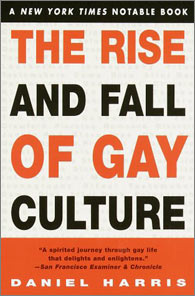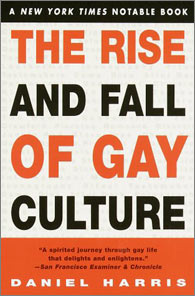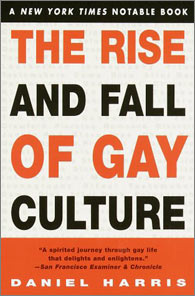The Rise And Fall Of Gay Culture
By: Daniel Harris
Ballantine Publishing Group
Pages: 278

The opera queen exemplifies gay aestheticism. Although straight people might look down on him for having sex with men, he looks down on his straight critics in turn for their crudity, philistinism, and mediocrity. They might hate him for being gay, but he despises them even more for wearing overalls, owning ugly furniture covered in protective plastic, listening to country music, and living someplace as hopelessly unfashionable as Kansas.
In gay cant, these worthless straight people are called "square states" because they live in states that look square on the map, with all the narrow-mindedness and ugliness this boring geography implies. Gays dismiss the taunts and threats of square states because these people are so worthless that their criticisms are meaningless. By issuing an aesthetic rebuke to his critics, the opera queen demotes potentially terrifying born again Christian gun owners into little more than ugly nattering insects. How can anyone fear someone as pathetic and crude as a square state?
In other words, Harris sees gay aestheticism as basically a rhetorical ploy - a way for gay men to raise themselves above their critics by appropriating high culture. From their seat high in the balcony of Lincoln Center, they look down on the mainstream straight world through their lorgnettes and sneer.
Unfortunately, there's a big problem with this strategy. Aestheticism is difficult to achieve. Most gay people aren't very educated or refined. In fact, most gay men aren't any more capable of grasping high culture than the straight philistines they want to despise. The average gay man is as apt to fall asleep at a five-hour performance of Tristan und Isolde as a straight prig from Kansas.
According to Harris, that's why so many gay men embraced Hollywood. They began to worship and imitate the strong women of old Hollywood, like Bette Davis, Joan Crawford, and Judy Garland. Because Hollywood usually portrayed these actresses' characters in rich, elegant, refined surroundings, gay men could appropriate this faux-refinement and make it their own. Hollywood movies were instant aestheticism, without the trouble of actually having to read Byron or buy season tickets to the Met.
Hollywood sophistication may have been tacky and shallow compared to the real thing, but it provided an adequate rhetorical substitute for the average gay man. Hollywood became his best defense against the straight world. He built a Maginot Line of attitude around himself with his well-honed Bette Davis imitation.
So how did this all change? According to gay mythology, the pivotal moment in gay history is Stonewall. Harris disagrees. He claims that Stonewall was actually an extremely minor event that has been built up into a myth. Gay people enjoy emphasizing the "Stonewall Rebellion" because it implies that gay people seized civil rights on their own.
Harris believes that the materialistic gay lifestyle has been the real key to gay rights. Gay people who don't marry and have children have extremely high disposable incomes compared to most consumers. Whereas straight people have to spend their money on their kids' braces and college tuition, gay people can happily squander their salary on expensive dinners of osso buco and tiramisu, weekend jaunts to a charming little B&B in Palm Springs, and black leather Prada thongs.
An aesthetic subculture means that gay people are often highly discerning and adventurous consumers on the cutting edge of fashion. And a high disposable income means that gays are more likely than straights to humor their shopping whims.

Under capitalism, multinationals pull society in their wake. The U.S. is a voracious consumer culture with very materialistic values. Not surprisingly, the success of gay people as model consumers made them respectable in the eyes of many Americans.
According to Harris, the real turning point in the struggle for gay rights wasn't Stonewall. Instead he portrays a quiet consumer revolution fought with Armani belts and sterling silver Tiffany hors d'oeuvres prongs rather than guns and stones. The vast economic power of gay people legitimized the struggle for gay rights.
Corporations have made a bundle off of gay culture. Not only have they learned to target model consumers from the gay community, but they also market the gay sensibility to straight people. Insightful entrepreneurs from Madonna to Calvin Klein to the producers of Sex and the City have proven that selling gay taste to the mainstream is a sure path to fame and fortune.
So Harris claims that a combination of aestheticism and high disposable incomes made gay people into consumer role models. And this positive image has helped push homosexuals into the mainstream. But how do we know that this argument is correct?
Harris points out that groups in American society that haven't been very economically successful, like blacks, have found it far more difficult to enter the mainstream than gays. Picket lines and acts of Congress are ultimately futile in winning true respect. Prosperity is the only sure way to obtain full civil rights.
In sum, Harris thinks that the success of the gay rights movement is inevitable for economic reasons. Gay people are simply too profitable to treat as lepers. The economic value of the homosexual to society will make him increasingly welcome in the mainstream.
So far, Harris' argument seems extremely optimistic. Consumerism will lift gay people onward and upward into a nirvana of both full equality and well-decorated lofts. But just when you start to think that gay people can have it all, Harris warns that integration has a high price. Once gay people are accepted into the mainstream, the traditional gay culture based on a defensive aestheticism is no longer necessary. Gay people must abandon their unique gay culture as the price of admission to suburbia.
Although multinationals are embracing gay people, they are also pushing for major changes in gay culture. For example, major gay magazines in the U.S. like Out and The Advocate lack images of naked men. They're also devoid of camp, kitsch, drag, bitchiness, and other old-fashioned gay delights. However much marketing directors covet the gay market, they won't tolerate having their products associated with drag queens sporting purple beehive hairdos. In response to the delicate sensitivities of the straight majority, gay publications have emasculated themselves into prim Victoriana to attract mainstream advertising.
Nor is this straightening out limited to collective gay culture. We see similar changes in individual gay behavior.

Humdrum straight culture is so much easier than the aesthetic frou-frou of the traditional gay sensibility. Human beings are lazy by nature. When high-maintenance aestheticism is no longer necessary, the majority of gay men will happily abandon it and start acting like the heterosexual slobs around them.
Harris believes that the entry of gays in mainstream American society will progressively destroy gay aestheticism, and gay culture will gradually meld into mainstream straight culture. The success of gay rights will end in cultural suicide.
The hopeless fate of gay aestheticism drips with irony. Gay culture has been steadfast and resilient through decades of terrible adversity. The only thing it cannot resist is acceptance.
We can already see the straightening out of gay culture in young gay men, who have no interest in trading catty bons mots or producing art films. Instead the youngest generation of gay Americans take their cultural cues from straight urban hip-hop culture. Nowadays it's hard to tell the difference between grungy young gay guys and their straight compatriots.
A dramatic generation gap is opening up in American gay culture. The older generation steadfastly preserves the unique aesthetic values of gay culture. They will keep on drinking Earl Grey tea with pinkies stubbornly suspended in the air until the bitter end. But more and more young gay men just want to be part of mainstream pop culture. Their values and ambitions are like the straight people around them. In many ways, they have a lot more in common with straight men their own age than with the older gays who continue to genuflect before the Muses.
Harris somberly warns that the entry of gay people into the mainstream will extinguish the uniquely fun and creative ethnic culture that gay people have developed over the past few decades. Nor will the loss be limited to the gay community. The decline of gay aestheticism holds enormous ramifications for all humanity. Once gay people don't feel the need to channel their energy into creative pursuits, but instead feel content to be just average, the world will be neither as beautiful nor as interesting as it was in the twentieth century.
Would you hire a straight guy to decorate your home? Of course not. But in the future, you might not have much of a choice. Harris believes that the extinction of gay culture is inevitable, and we should all mourn its impending demise.
The Rise and Fall of Gay Culture is an important book. Since its release, it has unleashed a firestorm of debate in American gay circles. It deserves to be carefully read and discussed in Asia as well.
Bret Hinsch is an Amercian acdemic who has been living in Taiwan for 10 years. He is also the author of 'Passions of the Cut Sleeve: The Male Homosexual Tradition in China.'
